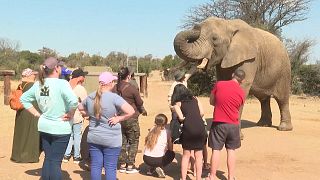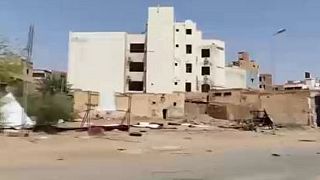Zimbabwe
Storm clouds are finally gathering over Hwange National Park, but it's too late for more than a hundred elephants who have succumbed to a prolonged drought at the start of the austral summer.
Simba Marozva and other rangers in the Zimbabwean reserve now only have to cut the tusks off the decomposing corpses to prevent poachers from finding them.
The 14,600 km2 park is home to more than 45,000 savannah elephants, so numerous that they are considered a threat to the environment.
The scene is heartbreaking: blackened corpses mark a landscape where the rains are more than six weeks late and temperatures regularly reach 40 degrees.
Some have fallen into dried-up potholes, others have spent their last hours in the shade of a tree. Many are baby elephants: all that remains is their shriveled skin over their bones, giving off a tenacious odour.
The intact tusk is a sign of natural death. In recent weeks, Simba Marozva and his colleagues have been on daily patrol in search of the corpses.
On average, an elephant drinks over 200 litres of water and eats 140 kilos of food a day.
More than 200 pachyderms had died from the drought by 2019. Rangers believe that the current situation is even more critical.
The quest for water is putting the elephants at risk, as they come dangerously close to inhabited areas on the outskirts of the park. Thirsty, they draw from the pools of houses or hotels or drink from water points contaminated by animal corpses.
- Thirsty treks -
Hwange Park is part of a vast transboundary conservation area encompassing the Okavango Delta and the majestic Zambezi River.
An aerial census in 2022 estimated that there were more than 225,000 elephants in the area.
While tens of thousands have been slaughtered throughout Africa by poachers and hunters since the 1970s, this conservation area is considered a success, with elephant numbers on the rise.
Almost too many, as the pressure on the park's resources is becoming untenable. And climate change is an added risk. According to environmentalists, there are twice as many elephants in Zimbabwe's nature parks as their capacity allows.
For Tinashe Farawo, spokesperson for the Zimbabwean parks, the death of elephants in Hwange has become a "big problem" but is not surprising given the size of the population.
"We're expecting it because it's hot and there's been very little rain so far," he told AFP.
"They suffer this stress and die".
Between September and the end of November, "we lost 112 elephants", he says, mainly "the old, the young and the sick".
"They die 50 or 60 metres from a water source because they can't stand the distance they have to travel to find food and water", he adds, relieved by the "few rains" that have fallen in recent days.
Global warming, which is pushing up temperatures and increasing the threat of longer droughts, is of course affecting other animals. But "we are paying more attention to the elephants, given the size of their carcasses", points out the spokesman.
Hwange Park, which is covered in dry grass, leafless trees and open semi-desert areas, has 104 solar-powered water boreholes to reach the water tables, whose water levels drop regularly.
This year, the drought has been exacerbated by the El Nino phenomenon. Dry waterholes are forcing elephants and other wild animals to travel long distances to drink. Some have crossed into Botswana and other neighbouring countries, where many deaths have been reported.












01:07
Only 35% of sustainable development goals on track to meet target, UN says
Go to video
Former Nigerian President to be buried today
Go to video
Islamic preachers in Burkina Faso rally against social media hate
02:30
Morocco’s oases struggle to survive amid growing desertification
01:26
Brazil elephant sanctuary welcomes its newest resident, rescued from a zoo in Argentina
Go to video
Ruto's $9M mega church sparks outrage amid Kenya's crisis